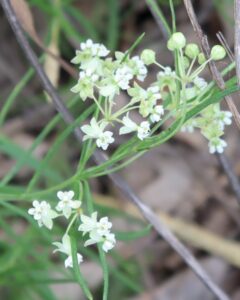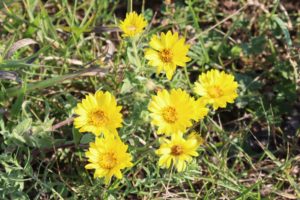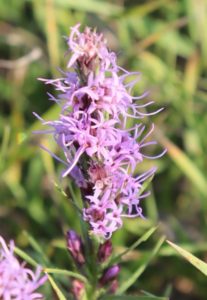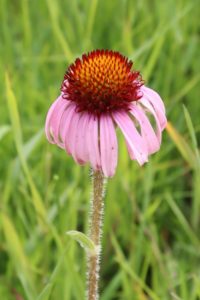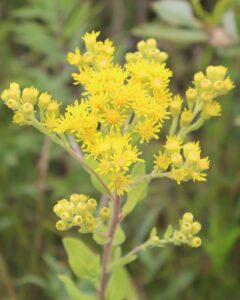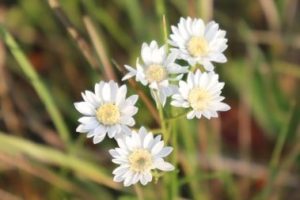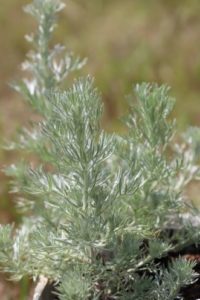These wildflowers are well suited to Manitoba’s dry and medium moisture prairies and woodlands. Some are more versatile and do well in moist habitats, too.
Dry soils are very well drained and usually composed of nutrient-poor sand, gravel or rock with some loam. Drought-like conditions are common, so vegetation is sparse or patchy and mostly short to mid-height.
Medium soils range from well-drained to somewhat poorly drained and may consist of sandy loam or clay with a thick, dark, nutrient-rich upper layer. Vegetation is dense and ranges from low (ground cover) to tall (>5 feet).
Flodman’s thistle
Sure, it’s prickly, but totally worth it!
Whorled Milkweed
A very fragrant and delicate-looking milkweed.
Yellow stargrass
Ranked S3, or vulnerable, in Manitoba.
Two-flowered cynthia
A rare find in Manitoba’s tall grass prairie/aspen parkland.
Hairy Golden-aster
Long, white hairs give this plant a grayish appearance.
Canada goldenrod
What’s really neat about this goldenrod is its pin-wheel leaf arrangement.
Blue-eyed grass
This miniature member of the iris family is a joy to see in spring-blooming prairies.
Dotted Blazingstar
One of my favourite dry prairie plants!
Purple Coneflower
Bold and beautiful, purple coneflower has a high tolerance for dry conditions.
Canadian lousewort
This hemi-parasite creates micro habitats where less-competitive forbs can thrive.
Dwarf Milkweed
Dwarf milkweed plays host to monarch caterpillars and its flowers are visited by a variety of insects.
Cooper’s Milkvetch
Striking clusters of large inflated pods are a beautiful pale yellow blushed with red. Ranked S1, critically imperilled, in Manitoba.
Cutleaf Anemone
Striking deep pink flowers brighten the June landscape, turning to cute balls of dense fluff by mid-summer.
Stiff Goldenrod
Stiff goldenrod is one of the relatively few prairie plants that seem to attract more attention when they're not flowering.
Western Silvery Aster
The magenta-coloured flowers are the most beautiful of all the asters.
Many-flowered Aster
The flowers provide a late-season nectar source for a wide range of insects.
Giant Hyssop
Plants have a sweet black licorice scent and flavour and make wonderful tea and medicine.
Evening Primrose
Large yellow flowers with heart-shaped petals and a wonderful fruity aroma.
Smooth Aster
Smooth aster brings welcomed colour and an important source of pollen and nectar to the late summer/fall landscape.
Purple Prairie Clover
Incredibly attractive flowers and aromatic leaves.
White Prairie Clover
Some species of cellophane bee are specific to white prairie clover and, in turn, are parasitized by cuckoo bees.
White Upland Goldenrod
My favourite goldenrod! White flowers with creamy centers are arranged in flat-topped clusters.
Canada Hawkweed
I like this plant because of its unique leaves, which have widely-spaced teeth or tooth-like projections along the edges and get characteristically smaller towards the top of the stem.
Black-Eyed Susan
Black-eyed susans are the primary nectar food plant for the endangered Powesheik skipperling.
Wild Bergamot
Excellent for flavouring all kinds of foods and highly medicinal, too.
Tall Cinquefoil
Stately, mid-sized plants with unique cream-coloured flowers.
Heliopsis, Ox-Eye
Bright yellow flowers seem to emit their own light.
Pink-Flowered Onion
The star-like flowers are just as flavourful as the precious bulbs.
Missouri Goldenrod
A typically low-stature goldenrod of dry prairies and gravel ridges.
Shrubby Evening Primrose
A beautiful addition to dry prairie sites.
Long-Headed Coneflower
Plants are quick to develop dense, fibrous root systems and often flower the first year.
Beautiful Sunflower
Short-stature sunflowers with a chocolatey scent.
Blanket Flower, Gaillardia
These simple flowers are definitely head-turners, attracting the attention of both people and a range of bees.
Pasture Sage
This is my favorite Manitoba sage. The soft, feathery, dusty green leaves are very unique and attractive.
Prairie Sage
Plants are beautifully scented and hold a special place in many Indigenous cultures.


